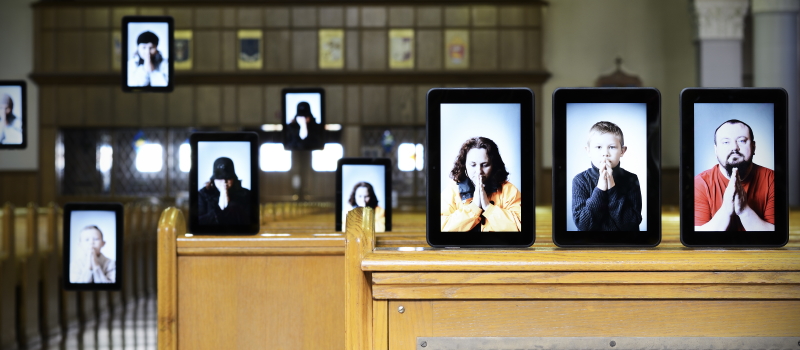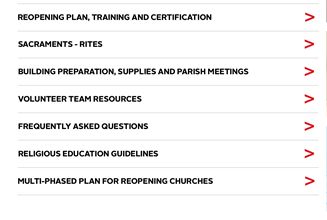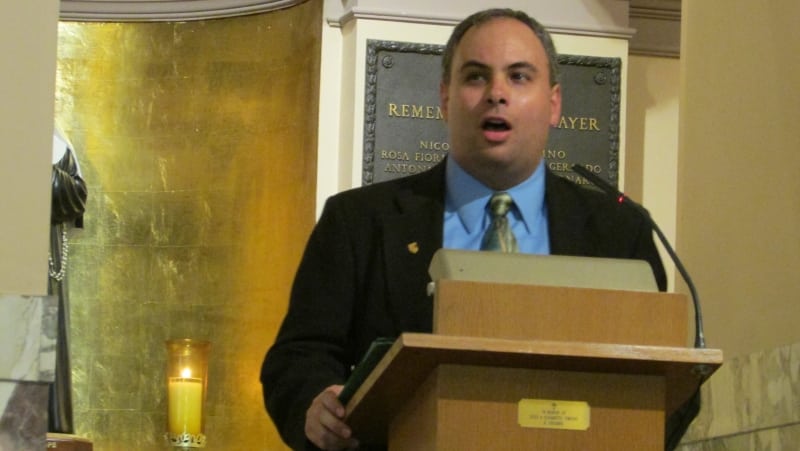In the spring, COVID-19 was new to us and caught us unaware and unprepared. Many dioceses made decisions to close church buildings during this time, and we scrambled to balance the shifting needs of parishes and communities. As of today, the United States has surpassed 217,000 deaths from COVID-19, and there have been nearly 8 million cases. As we head into the fall and prepare for a potential increase of COVID-19, let’s take a look at how Church re-openings were addressed over the course of the summer across the country. Considering these efforts will help us look at some of the questions that we need to be asking about ministry, preparation, sacraments and community.
Presented over the course of several articles, this overview will prepare us to think strategically about best practices for ministry in the months to come, as the liturgical calendar moves through Ordinary Time, and towards Advent.
In Pope Francis’ Urbi et Orbi address from March 2020, he urged us: “It is not the time of your judgment, but of our judgment: a time to choose what matters and what passes away, a time to separate what is necessary from what is not.” and on Sept 1 in for the World Day of Prayer for the Care of Creation, he writes: “[R]emember creation’s original vocation to exist and flourish as a community of love. We exist only in relationships: with God the Creator, with our brothers and sisters as members of a common family, and with all of God’s creatures within our common home.” The Trinity is relational, and we too are called to relationality. The language that we choose for our examination of ministry practices discloses theological presuppositions, and so we are going to begin with these two—discernment and existing in relationship— as the lenses we use to look at best practices.
Resource Parishes and Local Faith Communities
Our Lady of the Presentation Catholic Church in Lee’s Summit, Missouri reopened in the early days of June. As a parish, they provided several resources to their parishioners to assist in participation, when they were selected to come in the limited numbers required, and if they chose to do so. The pastor, Father Tom, has recorded weekly videos with messages for all parishioners, and there is an app available to download which offers messages from the parish, scripture readings, prayers, rosary meditations, and more. Throughout the summer, the parish has followed a schedule of three Sunday Masses, with time for cleaning between services, and one Saturday Mass.
For parishioners who are not participating at Mass in person, there are still resources provided that offer engagement and participation. The parish’s use of the national resources of Dynamic Parish is available in both Spanish and English, and allows congregants to elect whether they are participating in Mass via livestream or in person. The resource provides reflection questions and suggestions, including ways to quiet yourself to prepare for Mass before a livestream.
This parish’s approach to re-opening, which mirrors similar approaches in parishes across the country strengthens the community as a whole, no matter how they participate in the Mass by offering options for everyone. The variety of resources, whether audio, video, or reading material, and the delivery options of mobile app or computer, allow families to engage in faith formation as they’re able and as they’re comfortable, depending on their risk factors.
An Archdiocesan Model
At the diocesan level, the Archdiocese of Chicago has provided ongoing resources and guidance to parishes, working closely with them as they chose whether to re-open or to stay closed during the earlier months of the pandemic. Their comprehensive approach to COVID-19 began with a certification for parishes that wished to re-open. In addition to the certification, the archdiocese gathered resources in one place for services such as reservation options, video tips for reopening, sacramental guidelines, and other useful guidance. Here’s a picture of their main screen. Each section has a drop down that offers numerous resources within each option. The limit on attendees is capped at 15-20% of capacity as of this writing. There is continued attention to the health and safety of the community.
The archdiocese has provided many resources for faith formation, spirituality, and sacraments. However, it is good to focus on their underlying principles for these practices:
Four guiding principles undergird the multi-phased Plan:
- Everything possible should be done to provide people the solace of the church’s sacramental life in a timely and reasonable way.
- The current situation in Illinois remains dangerous and fragile. While much has been achieved, there remains the potential that the gains could be lost by a second more virulent wave.
- Trust needs to be established that the top priority in any Plan is the safety and wellbeing of people. We cannot take for granted that people will return just because churches are reopened.
- Calling people to exercise faithful citizenship will be key. Each Catholic will need to take personal responsibility for the common good as well as their own safety.
Their attention to the common good is most significant; it echoes Pope Francis’ words above. This focus is also reflected in their conversation around faith formation:
Through Renew My Church we are called to make disciples, build community and inspire witness. Especially during this time of great uncertainty and turmoil for the individuals, families and communities served by our Church, we must seek new and creative ways to lead them closer to Christ and one another and to share the Gospel as a light to our world. The Framework will serve as a guide toward continuing to build a stronger sense of missionary discipleship through your approach to religious education programming. By continuing to creatively engage your students and families in their own faith journeys, actively building community the Lord intends for your parish, and witnessing the Kingdom of God in the midst of a lost and fearful world, you are helping your parish move forward in answering the call to renew the Church of Jesus Christ. (Italics added)
These are the things we are called to do as we move through the fall and winter: creatively engage, build community, and inspire witness. The archdiocese has resourced its parishes well. Their strategic focus in the archdiocese helps shift our focus to best practices at the national level.
National Resources
At the National Level, America magazine provided a very useful resource for Catholics who wanted to consider returning in-person to Mass. The article, titled, “Should you go to Mass during a pandemic? 5 rules for discerning a hard question” draws on Ignatian discernment principles to outline a process for any Catholic trying to decide whether or not to participate in Mass in a location where Sunday obligation is still suspended, but some church buildings were open.
The article specifically engages the motivation to participate at Mass in person: Is it a movement which comes from God or not? The article focused on encouraging individuals who “could attend Mass without a substantially elevated risk to health,” but did not discuss the communal care aspect as comprehensively as the Archdiocese of Chicago’s directives did. The article also spoke to the ways in which we can continue to be in relationship with each other, and ministering to each other, even beyond the celebration of the Mass.
However, a video from America did consider some of these questions. It provided a “behind the scenes” look at how the story came about and offered a conversation between four of America’s staff, including a Jesuit. In the video, the questions that framed the conversation around the care for the common good , were: “What does it mean to be a catholic community?” “Were we ready to go back to ministry?” and “What is ministry?”. Now these broad questions are ones most of those in lay or ordained ministry have studied in preparation for ministry and parish life. They are questions worth considering freshly from time to time, especially now. What does our ministry look like now? Where were our ministries lacking before? One of the speakers discusses Chicago and mentions that the archdiocese was not mandating its parishes to open, but rather allowing them to discern what was best for their community. In the conversation, they also ask “Where is community life going during the pandemic, and after the pandemic?” I appreciated how these questions were raised within the context of participation in Mass. If you have 25 minutes to listen to the conversation, there is solid food for thought in it.
Planning and Living Into the Future
In this time of pandemic, we’ve been given an opportunity to reassess how we’ve been doing ministry and forming our faith community up until now. Who has been included, and who hasn’t? While we should mourn and grieve the many losses we have endured due to COVID-19 and its impacts, how can we examine the ways that video meetings and live-streamed liturgies and ministries enable us to truly meet people where they are – in their homes! What aspects of these unique developments might be carried forward in a post-pandemic Church? Who are the church? How is it more than the building? Is it the People of God, gathered? Is it also the People of God, scattered, in their homes? How can we catechize and empower the domestic church? What do we need to do differently to provide genuine pastoral care and solace to the people of God?
As the pandemic continues, we cannot escape these questions. We must strategically plan our responses in order to be effective. While we don’t know precisely what the future holds, we know and can learn enough to plan now, more than we could at the beginning of the pandemic. We would do well to be like the wise women in the wedding party in the Gospel story, who made sure their oil lamps were filled. We must continue to think and plan now for the unfolding future. Pope Francis, innovative parishes, archdioceses, and concern for the common good of the whole People of God invite us to continually consider pathways forward.
* * *
 Monica Herald has a master’s in theology from Washington Theological Union, and she read theology and philosophy during her undergrad time abroad at Oxford University. After working in parish ministry, she worked for the Franciscan Action Network. She’s passionate about educating the People of God and feels grateful for her exposure to charisms from numerous religious orders. Today, Monica writes and speaks about matters of faith and meaning-making.
Monica Herald has a master’s in theology from Washington Theological Union, and she read theology and philosophy during her undergrad time abroad at Oxford University. After working in parish ministry, she worked for the Franciscan Action Network. She’s passionate about educating the People of God and feels grateful for her exposure to charisms from numerous religious orders. Today, Monica writes and speaks about matters of faith and meaning-making.




 Request Dr. DelMonico's professional services for a liturgical, ministerial or leadership consultation, or for an academic or public presentation.
Request Dr. DelMonico's professional services for a liturgical, ministerial or leadership consultation, or for an academic or public presentation.